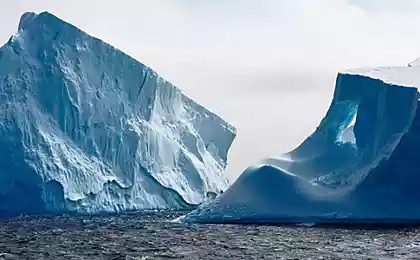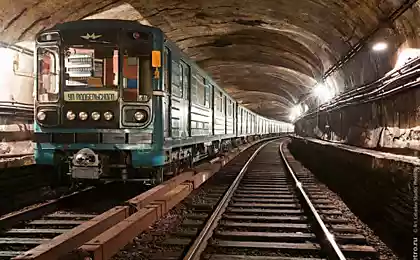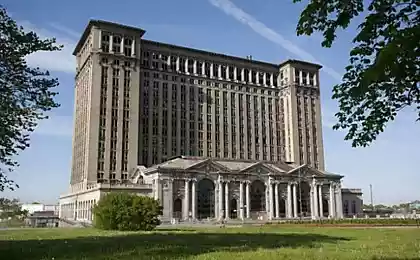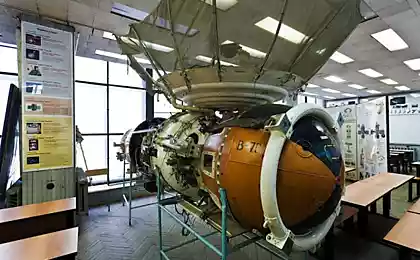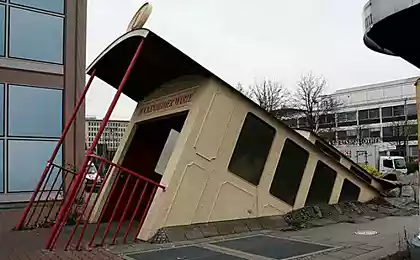791
Antarctic station at the South Pole
Amundsen-Scott station, named after the discoverer of the South Pole, is striking in its scale and technology. The complex of buildings around which thousands of kilometers there is nothing but ice is downright a separate world. We do not disclose all the secrets of science and research, but had an interesting tour of the residential blocks and showed how they live polar ...
41 Photo © Sergey Dolya
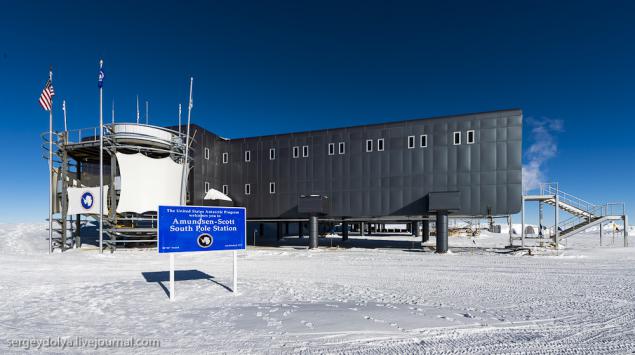
...

Initially, during the construction, the station was located exactly at the geographic South Pole, however, due to the movement of ice in a few years, the base has shifted in the direction of 200 meters:

It is our plane the DC-3. In fact, he was heavily modified by Basler and virtually all the stuffing in it, including avionics and engines, is new:

The plane can land on land and on the ice:

This photograph clearly shows how much the station is close to the historic South Pole (group of flags in the center). A single check box on the right - is the geographic South Pole:
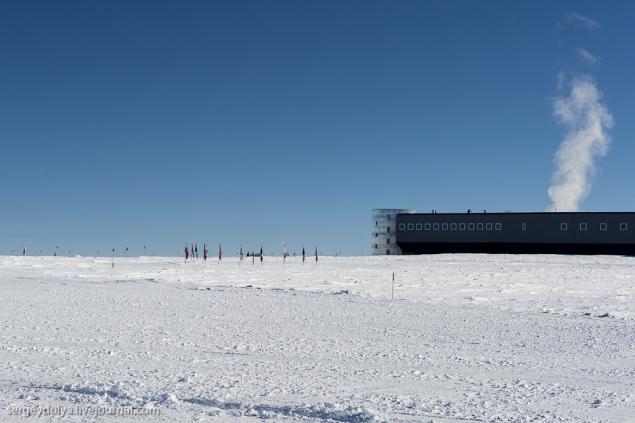
On arrival we were met by an employee station and gave us a tour of the main building:
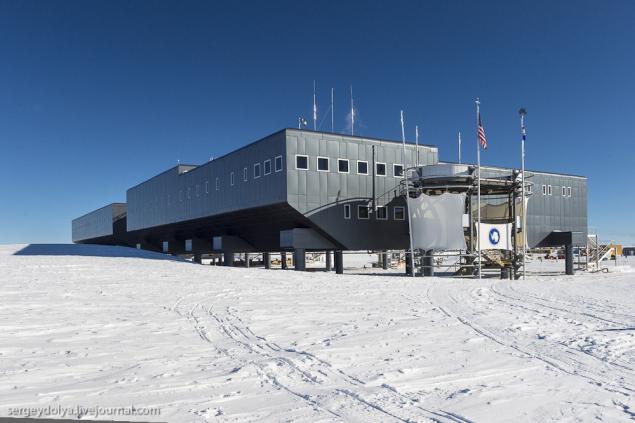
It stands on stilts, as well as many homes in the north. This is to ensure that the building does not melt the ice under him and "floated". In addition, the space below perfectly windswept (in particular, the snow under the station has not been cleaned even once since its erection):

Log in to the station: you must climb two flights of stairs. Due to the fact that the air is thin, it is not easy to do:

Housing Units:

At the pole, during our visit, it was -25 degrees. We arrived in full regalia - three layers of clothing, hats, balaclava, etc. - And then we suddenly met a man in a light sweaters and Crocs. He said he used to: survived several winters and the maximum frost, which is found here - minus 73 degrees. Forty minutes before we walked around the station, he was walking in this form:

The station is within easy striking. Let's start with the fact that it has a huge gym. Popular games among employees - basketball and badminton. For heating stations use 10,000 gallons of jet fuel per week:
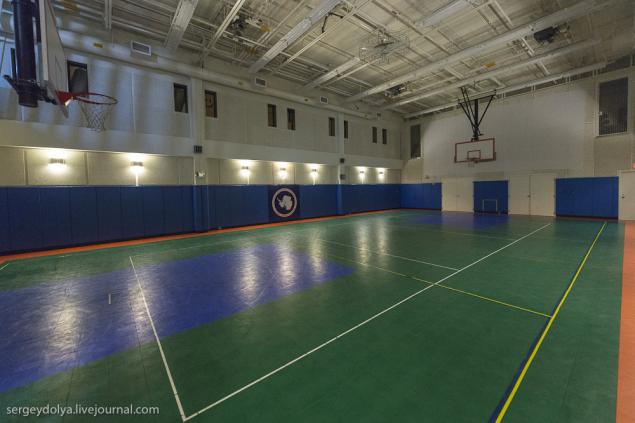
Some statistics: the station lives and works 170 people, 50 people remain in the winter food is free at the local canteen. They work 6 days a week, 9 hours a day. On Sunday the weekend. The cook off, too, and all tend to eat what was left uneaten in the refrigerator since Saturday:
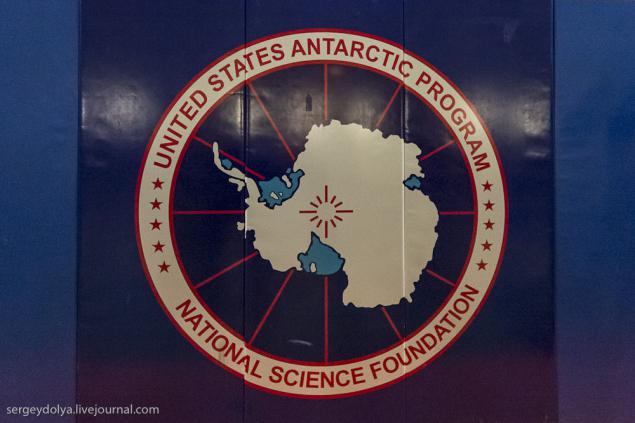
There is room for playing music (top, 2nd pictured), and in addition to sports, a gym:

There is room for trainings, conferences and similar events. As we passed, it took Spanish lessons:

Two-storey station. On each floor it penetrates a long corridor. Right leaving residential units left - scientific and research:
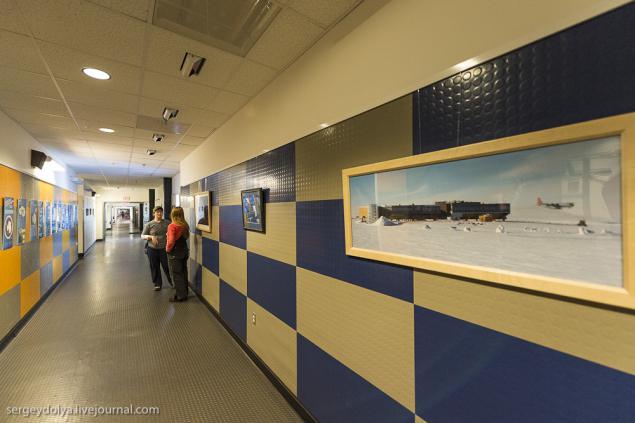
Meeting:

Near a balcony with views of the outbuildings station:

All that can be stored in unheated rooms, lies in these hangars:

This neutrino observatory Ice cube, through which scientists catch neutrinos from space. In short this is so: the clash of neutrino and an atom produces particles known as muons, and a flash of blue light, called Vavilov - Cherenkov radiation. In clear arctic ice IceCube optical sensors can detect it. Usually neutrino observatories are digging the mine at depth and is filled with water, but the Americans have decided not to be penny wise and Ice cube built at the South Pole, where plenty of ice. Size Observatory - 1 cubic kilometer of here, apparently, the name. The cost of the project - $ 270 million:

The theme of "make a bow" on the balcony with a view of our aircraft:
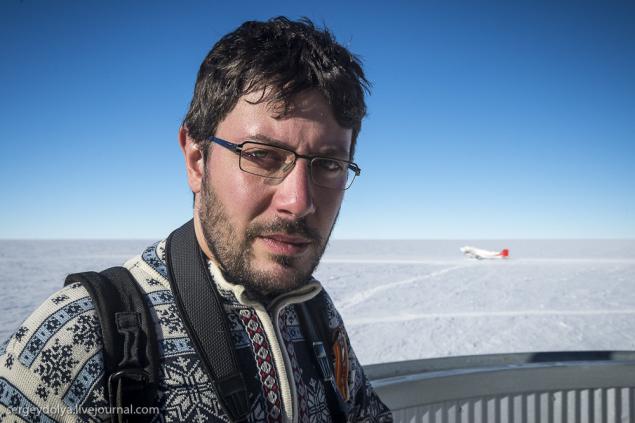
Across the base hanging invitations to seminars and master class. For example, the writer's workshop:

He drew attention to the garlands, trees, attach to the ceiling. Apparently the longing for summer and heat takes place among employees:

Old signboard station. Amundsen and Scott - the two poles of the discoverer, who conquered the South Pole almost simultaneously (well, when viewed in a historical context) with a difference per month:

Before this station was different, it was called "Dome". in 2010 it was finally dismantled, and this photograph shows the last day:

Lounge: billiards, darts, books and magazines:

Science lab. We were not allowed, but opened the door. Note the bins: the station is practiced separate collection of waste:

Pockets for firefighters. Standard American system: everyone has his own wardrobe, before it is completely ready outfit:

You just need to run up, jump in boots and don:
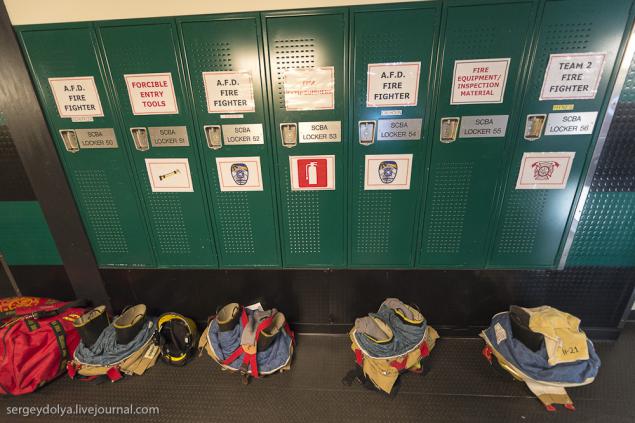
Computer Club. Perhaps, when the station was built, it was relevant, but now everyone has laptops and come here, I think, to cut a toy on the network. At the station there vayf, but have personal access to the Internet at a speed of 10 kbps. We, unfortunately, did not give, and I did not manage to zachekinitsya pole:

Just like in the camp ANI, water - the most expensive on the station. For example, wash the toilet is half dollar:
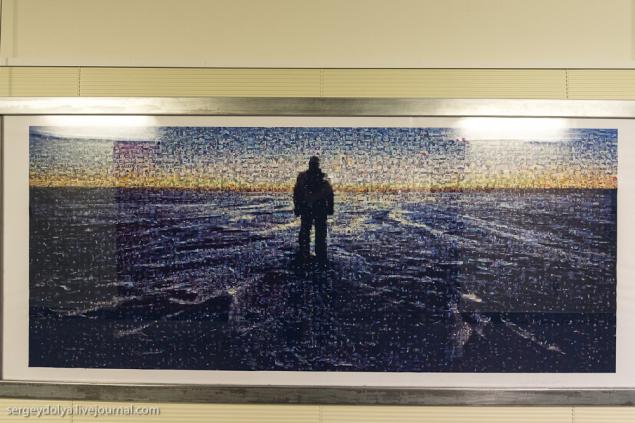
Medical Center:

I looked up as perfectly laid wires. Not because it is in our country and even more so somewhere in Asia:

The station is the most expensive and the most difficult of the gift shop in the world. A year ago, there was Evgeny Kaspersky, and he did not have the cash (like pay card). When I went, Jack gave a thousand dollars and asked to buy all that is in store. I, of course, filled souvenir bag, and then I began to quietly hate companions, because I created all of half an hour.
Incidentally, in this store you can buy beer and soda, but sell them only to employees stations:

There is a table with the seals "South Pole". We all took the passport and stamped:

The station even has its own greenhouse and a greenhouse. Now they do not need, because there is a message to the outside world. And in the winter, when a few months communicate with the outside world is interrupted, employees grow their vegetables and herbs:

Every employee has the right to use the laundry once a week. Go into the shower can 2 times a week for 2 minutes, ie 4 minutes per week. I was told that all the usual save and washed once every two weeks. Frankly, I smell already guessed:

Library:

39

This area of creativity. There is everything you can imagine: sewing thread, paper and ink drawing, assembly models, cardboard, etc. Now I really want to get to some of our polar station and to compare their way of life and equipped:

At the historic South Pole is the stick that has not changed since the days of the pioneers. A pointer to the geographic South Pole is moved every year in connection with the amendment to the movement of the ice. The station has a small museum knobs, accumulated over the years:

Source:
41 Photo © Sergey Dolya

...

Initially, during the construction, the station was located exactly at the geographic South Pole, however, due to the movement of ice in a few years, the base has shifted in the direction of 200 meters:

It is our plane the DC-3. In fact, he was heavily modified by Basler and virtually all the stuffing in it, including avionics and engines, is new:

The plane can land on land and on the ice:

This photograph clearly shows how much the station is close to the historic South Pole (group of flags in the center). A single check box on the right - is the geographic South Pole:

On arrival we were met by an employee station and gave us a tour of the main building:

It stands on stilts, as well as many homes in the north. This is to ensure that the building does not melt the ice under him and "floated". In addition, the space below perfectly windswept (in particular, the snow under the station has not been cleaned even once since its erection):

Log in to the station: you must climb two flights of stairs. Due to the fact that the air is thin, it is not easy to do:

Housing Units:

At the pole, during our visit, it was -25 degrees. We arrived in full regalia - three layers of clothing, hats, balaclava, etc. - And then we suddenly met a man in a light sweaters and Crocs. He said he used to: survived several winters and the maximum frost, which is found here - minus 73 degrees. Forty minutes before we walked around the station, he was walking in this form:

The station is within easy striking. Let's start with the fact that it has a huge gym. Popular games among employees - basketball and badminton. For heating stations use 10,000 gallons of jet fuel per week:

Some statistics: the station lives and works 170 people, 50 people remain in the winter food is free at the local canteen. They work 6 days a week, 9 hours a day. On Sunday the weekend. The cook off, too, and all tend to eat what was left uneaten in the refrigerator since Saturday:

There is room for playing music (top, 2nd pictured), and in addition to sports, a gym:

There is room for trainings, conferences and similar events. As we passed, it took Spanish lessons:

Two-storey station. On each floor it penetrates a long corridor. Right leaving residential units left - scientific and research:

Meeting:

Near a balcony with views of the outbuildings station:

All that can be stored in unheated rooms, lies in these hangars:

This neutrino observatory Ice cube, through which scientists catch neutrinos from space. In short this is so: the clash of neutrino and an atom produces particles known as muons, and a flash of blue light, called Vavilov - Cherenkov radiation. In clear arctic ice IceCube optical sensors can detect it. Usually neutrino observatories are digging the mine at depth and is filled with water, but the Americans have decided not to be penny wise and Ice cube built at the South Pole, where plenty of ice. Size Observatory - 1 cubic kilometer of here, apparently, the name. The cost of the project - $ 270 million:

The theme of "make a bow" on the balcony with a view of our aircraft:

Across the base hanging invitations to seminars and master class. For example, the writer's workshop:

He drew attention to the garlands, trees, attach to the ceiling. Apparently the longing for summer and heat takes place among employees:

Old signboard station. Amundsen and Scott - the two poles of the discoverer, who conquered the South Pole almost simultaneously (well, when viewed in a historical context) with a difference per month:

Before this station was different, it was called "Dome". in 2010 it was finally dismantled, and this photograph shows the last day:

Lounge: billiards, darts, books and magazines:

Science lab. We were not allowed, but opened the door. Note the bins: the station is practiced separate collection of waste:

Pockets for firefighters. Standard American system: everyone has his own wardrobe, before it is completely ready outfit:

You just need to run up, jump in boots and don:

Computer Club. Perhaps, when the station was built, it was relevant, but now everyone has laptops and come here, I think, to cut a toy on the network. At the station there vayf, but have personal access to the Internet at a speed of 10 kbps. We, unfortunately, did not give, and I did not manage to zachekinitsya pole:

Just like in the camp ANI, water - the most expensive on the station. For example, wash the toilet is half dollar:

Medical Center:

I looked up as perfectly laid wires. Not because it is in our country and even more so somewhere in Asia:

The station is the most expensive and the most difficult of the gift shop in the world. A year ago, there was Evgeny Kaspersky, and he did not have the cash (like pay card). When I went, Jack gave a thousand dollars and asked to buy all that is in store. I, of course, filled souvenir bag, and then I began to quietly hate companions, because I created all of half an hour.
Incidentally, in this store you can buy beer and soda, but sell them only to employees stations:

There is a table with the seals "South Pole". We all took the passport and stamped:

The station even has its own greenhouse and a greenhouse. Now they do not need, because there is a message to the outside world. And in the winter, when a few months communicate with the outside world is interrupted, employees grow their vegetables and herbs:

Every employee has the right to use the laundry once a week. Go into the shower can 2 times a week for 2 minutes, ie 4 minutes per week. I was told that all the usual save and washed once every two weeks. Frankly, I smell already guessed:

Library:

39

This area of creativity. There is everything you can imagine: sewing thread, paper and ink drawing, assembly models, cardboard, etc. Now I really want to get to some of our polar station and to compare their way of life and equipped:

At the historic South Pole is the stick that has not changed since the days of the pioneers. A pointer to the geographic South Pole is moved every year in connection with the amendment to the movement of the ice. The station has a small museum knobs, accumulated over the years:

Source:


